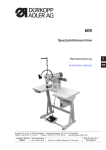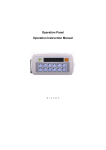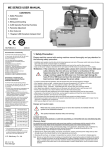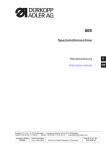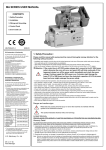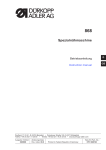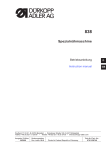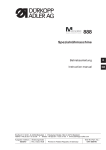Download Duerkopp Adler 609 Instruction manual
Transcript
609 Spezialnähmaschine Betriebsanleitung D Instruction manual GB Postfach 17 03 51, D-33703 Bielefeld • Potsdamer Straße 190, D-33719 Bielefeld Telefon +49 (0) 521 / 9 25-00 • Telefax +49 (0) 521 / 9 25 24 35 • www.duerkopp-adler.com Ausgabe / Edition: 10/2007 Änderungsindex Rev. index: 01.0 Printed in Federal Republic of Germany Teile-Nr./Part.-No.: 0791 609741 Alle Rechte vorbehalten. Eigentum der Dürkopp Adler AG und urheberrechtlich geschützt. Jede, auch auszugsweise Wiederverwendung dieser Inhalte ist ohne vorheriges schriftliches Einverständnis der Dürkopp Adler AG verboten. All rights reserved. Property of Dürkopp Adler AG and copyrighted. Reproduction or publication of the content in any manner, even in extracts, without prior written permission of Dürkopp Adler AG, is prohibited. Copyright © Dürkopp Adler AG - 2007 Foreword This instruction manual is intended to help the user to become familiar with the machine and take advantage of its application possibilities in accordance with the recommendations. The instruction manual contains important information on how to operate the machine securely, properly and economically. Observation of the instructions eliminates danger, reduces costs for repair and down-times, and increases the reliability and life of the machine. The instruction manual is intended to complement existing national accident prevention and environment protection regulations. The instruction manual must always be available at the machine/sewing unit. The instruction manual must be read and applied by any person that is authorized to work on the machine/sewing unit. This means: – – – Operation, including equipping, troubleshooting during the work cycle, removing of fabric waste, Service (maintenance, inspection, repair) and/or Transport. The user also has to assure that only authorized personnel work on the machine. The user is obliged to check the machine at least once per shift for apparent damages and to immediatly report any changes (including the performance in service), which impair the safety. The user company must ensure that the machine is only operated in perfect working order. Never remove or disable any safety devices. If safety devices need to be removed for equipping, repairing or maintaining, the safety devices must be remounted directly after completion of the maintenance and repair work. Unauthorized modification of the machine rules out liability of the manufacturer for damage resulting from this. Observe all safety and danger recommendations on the machine/unit! The yellow-and-black striped surfaces designate permanend danger areas, eg danger of squashing, cutting, shearing or collision. Besides the recommendations in this instruction manual also observe the general safety and accident prevention regulations! General safety instructions The non-observance of the following safety instructions can cause bodily injuries or damages to the machine. 1. The machine must only be commissioned in full knowledge of the instruction book and operated by persons with appropriate training. 2. Before putting into service also read the safety rules and instructions of the motor supplier. 3. The machine must be used only for the purpose intended. Use of the machine without the safety devices is not permitted. Observe all the relevant safety regulations. 4. When gauge parts are exchanged (e.g. needle, presser foot, needle plate, feed dog and bobbin) when threading, when the workplace is left, and during service work, the machine must be disconnected from the mains by switching off the master switch or disconnecting the mains plug. 5. Daily servicing work must be carried out only by appropriately trained persons. 6. Repairs, conversion and special maintenance work must only be carried out by technicians or persons with appropriate training. 7. For service or repair work on pneumatic systems, disconnect the machine from the compressed air supply system (max. 7-10 bar). Before disconnecting, reduce the pressure of the maintenance unit. Exceptions to this are only adjustments and functions checks made by appropriately trained technicians. 8. Work on the electrical equipment must be carried out only by electricians or appropriately trained persons. 9. Work on parts and systems under electric current is not permitted, except as specified in regulations DIN VDE 0105. 10. Conversion or changes to the machine must be authorized by us and made only in adherence to all safety regulations. 11. For repairs, only replacement parts approved by us must be used. 12. Commissioning of the sewing head is prohibited until such time as the entire sewing unit is found to comply with EC directives. 13. The line cord should be equipped with a country-specific mains plug. This work must be carried out by appropriately trained technicians (see paragraph 8). It is absolutely necessary to respect the safety instructions marked by these signs. Danger of bodily injuries ! Please note also the general safety instructions. Content page: Preface and general safety instructions Part 1: Operating Instructions class 609 (Edition 10/2007) 1. Product description . . . . . . . . . . . . . . . . . . . . . . . . . . . . . . . . . . . . . . . . . . . . 5 2. Designated use . . . . . . . . . . . . . . . . . . . . . . . . . . . . . . . . . . . . . . . . . . . . . . . 5 3. Subclasses . . . . . . . . . . . . . . . . . . . . . . . . . . . . . . . . . . . . . . . . . . . . . . . . . . 6 4. Optional equipments . . . . . . . . . . . . . . . . . . . . . . . . . . . . . . . . . . . . . . . . . . . 6 5. Technical Data . . . . . . . . . . . . . . . . . . . . . . . . . . . . . . . . . . . . . . . . . . . . . . . . 7 6. 6.1 6.2 6.3 6.4 6.5 6.6 6.7 6.8 6.9 Operation Threading the needle thread . . . . . Adjusting the needle thread tension Opening the needle thread tensioner Winding on the hook thread. . . . . . Fitting the hook-thread bobbin . . . . Adjusting the hook-thread tension . Inserting and changing the needle . Adjusting the sewing foot stroke . . Adjusting the sewing foot pressure . . . . . . . . . . . . . . . . . . . . . . . . . . . . . . . . . . . . . . . . . . . . . . . . . . . . . . . . . . . . . . . . . . . . . . . . . . . . . . . . . . . . . . . . . . . . . . . . . . . . . . . . . . . . . . . . . . . . . . . . . . . . . . . . . . . . . . . . . . . . . . . . . . . . . . . . . . . . . . . . . . . . . . . . . . . . . . . . . . . . . . . . . . . . . . . . . . . . . . . . . . . . . . . . . . . . . . . . . . . . . . . . . . . . . . . . . . . . . . . . . . . . . . . . . . . . . . . . . . . . . . . . . . . . . . . . . . . . . . . . . . . . . . . . . 8 8 9 10 11 12 13 14 15 7. 7.1 7.2 7.2.1 7.2.2 7.2.3 Control unit and operating panel General . . . . . . . . . . . . . . . . . . . . . Sewing drive HoHsing HVP 70-4-ED-2-CE Control unit keys (sewing mode) . . . . . . . Operating panel keys (Type C300) . . . . . Changing the parameter values . . . . . . . . . . . . . . . . . . . . . . . . . . . . . . . . . . . . . . . . . . . . . . . . . . . . . . . . . . . . . . . . . . . . . . . . . . . . . . . . . . . . . . . . . . . . . . . . . . . . . . . . . . . . . . . . . . . . . . . . . . . . . . . . . . . . . . . . . . . . . . . . . . . . . . . . . . . . . . . . . . 16 16 17 18 19 8. Sewing . . . . . . . . . . . . . . . . . . . . . . . . . . . . . . . . . . . . . . . . . . . . . . . . . . . . . 19 9. 9.1 9.2 Maintenance Cleaning and testing . . . . . . . . . . . . . . . . . . . . . . . . . . . . . . . . . . . . . . . . . . . . . Lubrication . . . . . . . . . . . . . . . . . . . . . . . . . . . . . . . . . . . . . . . . . . . . . . . . . . . 23 24 . . . . . . . . . . . . . . . . . . . . . . . . . . . GB 1. Product description The DÜRKOPP ADLER 609 is a single needle double lockstitch cylinder arm machine for attaching and basting works on jackets, coats, suit jackets and the like. The machine is equipped with an integrated DC direct drive and an operating panel for the programming of the sewing parameters. · · · · · · · · · · Double lockstitch cylinder arm machine Integrated direct current direct drive Easy operating by means of the external operating panel. Automatic thread trimmer under the throat plate. Small horizontal hook. Integrated winder for the bobbin thread. Simple pulling of the thread when moving the material through eccentric actuated tension release. Easy processing of materials up to 19 mm thick. Simplified inserting of the material through the reverse function of the needle. Easy handling through cylindrical covering on the free arm. GB 2. Designated use The 609 is a special sewing machine designed for sewing light to medium-heavy material. Such material is generally made of textile fibers, but it may also be leather. It is used in the clothing, footwear and leatherwear industries as in domestic and motor-vehicle upholstery. This special sewing machine can also be used to produce so-called technical seams. In this case, however, the operator must assess the possible dangers which may arise (with which DÜRKOPP ADLER AG would be happy to assist), since such applications are on the one hand relatively unusual and, on the other, so varied that no single set of criteria can cover them all. The outcome of this assessment may require appropriate safety measures to be taken. Generally only dry material may be sewn with this machine. The material may be no thicker than 9 mm when compressed by the lowered sewing feet. The material may not contain any hard objects, since if it does the machine may not be operated without an eye-protection device. No such device is currently available. The seam is generally produced with textile-fibre sewing thread of gauge up to 80/3 Nm. Before using any other thread the possible dangers arising must be assessed and appropriate safety measures taken if necessary. This special sewing machine may be set up and operated only in dry, well-maintained premises. If the sewing machine is used in premises which are not dry and well-maintained it may be necessary to take further precautions (which should be agreed in advance - see EN 60204-31:1999). 5 As manufacturers of industrial sewing machines we proceed on the assumption that personnel who work on our products will have received training at least sufficient to acquaint them with all normal operations and any possible hazards which these may involve. 3. 4. Subclasses 609-100101 Single needle double lockstitch free-arm machine for manual material feed. Order No. MG55 400344 Optional equipment Stand with table plate 1060x550 Table extension for accomplishing attaching work flat, table top 1400 x 550mm Sewing lamp with flexible arm, lamp 12V/20W Table clamp for clamping the sewing lamp onto the table plate. Add-on kit socket for the sewing lamp for the electrical connection under the table top. Optional equipments 0609 590014 9822 510026 9822 510027 9870 001021 Further available documents concerning the class 609 0791 609801 Parts List 0791 609641 Service Instructions 6 5. Technical data Rated noise value Lc: Workplace-related emission value in accordance with DIN 45635-48-A-1-KL2 Lc = xx dB (A) Class: 609 Stitch length: manual Sewing foot stroke: 15 mm Speed: 800 [min -1 ] Material: double Skai 1,6 mm 900 g/m 2 DIN 53352 Needle system: 134-35 Needle thickness (depending on the equipment no.) [Nm] 80 - 100 Max. thread thickness: [Nm] 80/3 Speed: - max. - ex factory [min -1 ] [min -1 ] 1000 800 Max. stitch length: manual Max. sewing foot stroke: [mm] 19,5 Max. clearance under the sewing foot with the needle bar positioned: [mm] 20 Rated voltage: GB 1 x 220-240V, 50/60HZ Dimensions: - Stand MG 55-3 [mm] 1540 x 1060 x 550 Working height: - Stand MG 55-3 [mm] 750 - 900 Weight (only the machine head) [KG] 32 7 6. Operation 6.1 Threading the needle thread Caution: Danger of injury! Turn off the main switch ! The needle thread may only be threaded with the sewing machine switched off. 2 1 6.2 Adjusting the needle thread tension Pre-tension In order to guarantee a safe function of the thread trimmer with the class 609, it is necessary that the needle thread is under residual tension when the main tensioner 2 is open. The residual tension is generated by the pre-tensioner 1. The pre-tensioner 1 determines the length of the needle thread end after the thread trimming. The pre-tension 1 should be set lower than the main tension 2. – Adjust the pre-tension 1 by turning the knurled nut. – After major changes on pre-tension 1, adjust the main tension 2 accordingly. Main tension The main tensioner 2 should be set to the minimum possible tension. The looping of the threads must be in the center of the material (see fig. a). With thin material excessive thread tension can cause unwanted gathering and thread breakage. – Adjust the main tensioner 2 so that the stitches are uniform. 8 Fig. A Correct thread loop in the center of the material Fig. B Needle-thread tension too low or hook-thread tension too high Fig. C Needle-thread tension too high or hook-thread tension too low 6.3 Opening the needle thread tensioner GB 2 1 Electromagnetically The main tensioner 2 will be opened electromagnetically: · During thread trimming via solenoid 1. Mechanically The main tensioner 2 will be opened mechanically: · Through an eccentric on the arm shaft, each time the thread lever reaches a point 2 mm after the upper dead center (UDC). 9 6.4 Winding on the hook thread 4 – – – – – – – 10 3 2 1 Thread the hook thread as shown in the picture above. Fit the bobbin 3 on the bobbin-winder shaft 2. Wind approximately five coils of hook thread anti-clockwise onto the bobbin core. Cut the thread end with the knife and clamp it. Press the release lever 1 against the bobbin. The bobbin-winder wheel is pressed against the driving wheel of the arm shaft. Adjusting the tension 4. The hook thread should be wound on with minimum tension. Sewing. The release lever 1 terminates the process automatically as soon as the bobbin is full. 6.5 Fitting the hook-thread bobbin 3 1 2 6 5 4 1 Caution: Danger of injury! Turn off the main switch ! The hook-thread bobbin may only be changed with the machine switched off. GB Remove the empty bobbin – Turn the hand wheel, until the needle bar has reached its highest position. – Open the cap 2 on the arm cover. – Raise bobbin-housing flap 1. – Remove the upper part of the bobbin-housing 3 together with the bobbin. – Remove the empty bobbin from the upper part of the bobbin-housing 3. Threading the hook thread – Place the full bobbin 4 in the upper part of the bobbin-housing 3. The bobbin 4 must rotate in the direction of the arrow when the thread is pulled. – Draw the hook thread through the slit 5 under the tension spring 6. – Pull approximately 8 cm of the hook thread out of the upper part of the bobbin housing 3. – Replace the upper part of the bobbin housing 3 again. – Close the cap 2. 11 6.6 Adjusting the hook-thread tension 2 3 1 5 4 Adjusting the braking spring 1 The braking spring 1 prevents the idle motion of the bobbin when the machine halts or during a jerky drawing of the hook thread for example when pulling the thread of the thread-pulling knife. – Unscrew the adjustment screw 5 until no tension remains in the tension spring 3. – Adjust the braking spring 1 with adjustment screw 4. The braking force is correctly adjusted if the braking spring 1 is approx. 1 mm above the surface 2. Adjusting the tension spring 3 – Adjust the tension spring 3 with adjustment screw 5. To increase the hook-thread tension = turn screw clockwise To decrease the hook-thread tension = turn screw anti-clockwise For stitch formation see sketch on page 9. 12 6.7 Inserting and changing the needle 1 2 3 Caution: Danger of injury! Turn off the main switch ! The needle may only be changed with the sewing machine switched off. GB – – – – Turn the handwheel, until the needle bar 1 has reached its highest position. Loosen screw 2. Pull the needle downwards out of the needle bar 1. Push in the new needle into the hole of the needle bar 1 until it stops. ATTENTION! When viewed from the operator side, the needle scarf 1 must point towards the back of the machine (see sketch). – Tighten screw 2. ATTENTION! When changing to another needle size, the distance between hook and needle must be readjusted (see service instructions). Ignoring the above mentioned hint can cause the following mistakes: · · When inserting a thinner needle: Missed stitches Damage of the thread When inserting a thicker needle: Damage of the hook tip and the needle 13 6.8 Adjusting the sewing foot stroke 3 2 1 Caution: Danger of injury! Turn off the main switch ! The sewing foot stroke may only be adjusted with the machine switched off. The height of the sewing-foot stroke is determined by the position of connecting rod 1. Adjusting the sewing foot stroke – Loosen the nut 3 on the back of the machine arm. – Shift the connecting rod 1 within the shifting lever 2. Connecting rod completely at the top = maximum sewing foot stroke (20 mm) Connecting rod completely at the bottom = minimum sewing foot stroke (10 mm) – Tighten the nut 3. 14 6.9 Adjusting the sewing foot pressure max 25 mm 2 – – – 1 Loosen the counter nut 1. The required sewing foot pressure can be adjusted with screw 2. To increase the sewing foot pressure = turn screw 2 clockwise. To decrease the sewing-foot pressure = turn screw 2 anti-clockwise. Tighten the counter nut 1. ATTENTION! The set screw 2 shall not be screwed out more than 25 mm. 15 GB 7. Control unit and operating panel ATTENTION! These operating instructions give the key functions and describe how operator-level parameter values are changed by the operator. For a detailed description of the control unit, please consult the enclosed current issue of the operating manual of the motor manufacturer. 7.1 General For the programming and the entering of sewing parameters, use the function keys of the control unit and the operating panel. These operating instructions give an overview of the basic functions and the operating elements of the control unit and the operating panel. Further information for the programming are described in the manual of the motor manufacturer. An operating manual of the motor manufacturer is enclosed with each machine. If needed the manual can also be downloaded in further languages from the website of the DÜRKOPP ADLER AG. RESET If the control unit is hopelessly out of adjustment, this function allows the technician to reset all adjusted values to their default (ex factory) settings. The function is described in the manual of the motor manufacturer! 7.2 Sewing drive HoHsing HVP 70-4-ED-2-CE The English version of the manual for the HoHsing HVP 70-4-ED-2-CE sewing drive is enclosed with each machine. If needed the manual can also be downloaded in further languages from the website of the DÜRKOPP ADLER AG: www.duerkopp-adler.com. 16 7.2.1 Control unit keys (sewing mode) If the operating panel C300 is connected, the setting done through the operating panel will have higher priority than settings done on the control unit. Switch free sewing**/ tacking / programmed seam segment Bartacking seam begin ON/ OFF Programming key Bartacking seam end* ON/OFF Needle position top / bottom at machine stop Automatic sewing foot lifting* after the thread trimming ON / OFF Softstart ON / OFF Automatic sewing foot lifting after machine stop UP / DOWN Indicator for the motor’s sense of rotation Display for the number of backtack stitches set GB Setting the stitch number (Range 0 - F) * A = 10 Stitches… * B = 15 Stitches .... * Function disabled with this machine. ** Essentially the setting “free sewing” will be used with this machine. 17 7.2.2 Operating panel keys (Type C300) Explanation of the important function keys for the operation of the class 609: B Initial bartack. For the class 609, programming of a given number B of start stitches. Selection of the stitch setting A-B-C-D or E-F or G-H Setting and displaying the stitch settings A-H Thread trimming ON / OFF Needle position setting UP / DOWN Free sewing One stitch basting ON / OFF 18 7.2.3 Changing the parameter values For checking purposes or after a reset the parameter values must be set according to the parameter sheet (Part No. 9800 370001 PB40) enclosed in the accessories. If required, the current parameter sheet can be downloaded from the website of the DÜRKOPP ADLER AG within the download area: www.duerkopp-adler.com. The setting of the parameter is described in the manual provided with the sewing drive. 8. Sewing GB Caution: Danger of injury! Please proceed very cautiously, due to the high sewing foot stroke (up to 19,5 mm) and the related increased danger of injury ! This description is based on the following assumptions: – The main switch is turned on. The following functions are set at the operating panel: – Initial bartack: 3 preset attaching stitches – The needle reverse function is set in the control parameters. – The needle position setting is up. – The thread trimmer is switched on. – The last sewing process was completed with thread cutting. 19 Operating and function sequence: Sewing process Prior to sewing Starting position Position material for starting the seam. Operation / explanation - Pedal in rest position The machine is at a halt. Needle up Sewing foot in highest position - Place the material under the sewing foot At the seam start Sewing Press the key (bartack/attaching stitches) of the operating panel. LED ON: Function bartack/attaching stitches ON. LED OFF: Function bartack/attaching stitches OFF. B One stitch basting with attaching stitches - Prerequisite: on the operating panel the key has its LED ON B - Prerequisite: on the operating panel the key (one stitch basting) has its LED ON - Push the pedal forwards. - The machine sews attaching stitches with the bartack speed - During the attaching of the material the machine should be fed slightly. - After attaching, the machine stops with the thread lever in upper position with the thread tension open (even if the pedal is pressed continuously, only the attaching stitches will be sewn). - Each time the pedal is pushed forward, a single stitch will be sewn no matter how long the pedal is pushed forward. It is possible to pull any length of single stitch. Disabling the one stitch basting function is only possible after the thread trimming. Sewing continuous seam with attaching stitches - Prerequisite: on the operating panel the key has its LED ON B - Prerequisite: on the operating panel the key (one stitch basting) has its LED OFF - Push pedal forwards and keep it pushed. - The machine sews attaching stitches with the bartack speed, then continues at the speed of rotation set by the pedal. - Feed the material manually 20 Sewing continuous seam without attaching stitches - Prerequisite: on the operating panel the key has its LED OFF B - Prerequisite: on the operating panel the key (one stitch basting) has its LED OFF - Push pedal forwards and keep it pushed. - The machine sews at the speed of rotation set by the pedal. - Feed the material manually Even during the continuous seam, it is possible to sew a single stitch by pushing briefly the pedal! In mid-seam (only valid with sewing continuous seam) Interrupt the sewing process Resume the sewing process - Release pedal (rest position). The machine stops in the needle up position - Each time that the pedal is pushed briefly the machine execute exactly one stitch. If you actuate the pedal longer the machine will sew continuously. - Push the pedal forwards. The sewing machine sews at the speed of rotation set by the pedal. At the seam end with thread trimming - Push pedal backwards and keep it pushed. - The thread will be cut - Sewing foot in highest position (reverse function) The material can be removed. without thread trimming - Push pedal backwards and keep it pushed. - Sewing foot in highest position (reverse function) - The material can be removed. The threads must be cut manually 21 GB Notes: 22 9. Maintenance Caution: Danger of injury! Turn off the main switch ! Maintenance may only be carried out with the machine switched off! Maintenance work must be carried out no less frequently than at the intervals given in the tables (see ”operating hours” column). Maintenance intervals may need to be shorter when processing heavy-shedding materials. 9.1 Cleaning and testing A clean machine is a trouble-free machine! 1 GB Maintenance work to be carried out Machine head - Remove lint, pieces of thread and other debris Explanation -Places in special need of cleaning: Operating hours 8 - Clean the area under the needle plate from lint, pieces of thread. You can do it with an air blow gun. - Area around the hook - Clean under the bobbin braking spring 1 from lint. Lift the spring slightly for example with a needle and blow it. - Needle thread tensioner - Thread trimmer Sewing drive - Check the condition and the tension of the toothed belt. It must be possible to depress the toothed belt by about 10 mm when pressing it with a finger at its mid-point. 160 23 9.2 Lubrication Caution: Danger of injury! Oil can cause skin eruptions. Avoid protracted contact with the skin. In the event of contact, thoroughly wash the affected area. ATTENTION! The handling and disposal of mineral oils is subject to legal regulation. Deliver used oil to an authorised collection point. Protect your environment. Take care not to spill oil. 12 13 To lubricate the special sewing machine use only DA-68 lubricating oil or an equivalent oil of the following specification: Viscosity at 40° C : Flashpoint: 68 mm 2 /s 212 °C DA-68 is available from DÜRKOPP ADLER AG retail outlets under the following part numbers: 1-liter-container: 9047 000041 5-liter-container: 9047 000042 14 1 15 2 3 4 5 6 7 8 9 10 11 Maintenance work to be carried out Explanation - Supply the oil hole 1-15 Remove the face cover. - Supply all the marked oil hole in the pictures with a few oil drops. 24 Operating hours 8



























